
The Grayl Ultralight Purifier Bottle is an innovative water treatment solution designed to remove viruses, bacteria, protozoa, chemicals, and heavy metals from backcountry water sources. Unlike other water filters and treatment methods, the Grayl Purifier does not require batteries, ultraviolet light bulbs, hoses, straws, pumping, sucking, or waiting for a chemical reaction to complete. It also doesn’t require carrying an extra reservoir or container to drink from and doesn’t turn into a wet drippy thing that you need to store on the outside of your backpack to keep it from making your other gear wet while you continue on your journey. Intrigued?
Grayl Ultralight Purifier Bottle
Reliability
Weight
Treatment Capacity
Speed
Ease of Use
Very Well Designed
The Grayl Purifier works like a French coffee press with an outer bottle and a plunger that fits inside it. You fill the outer bottle with water from a stream or lake and then press the plunger which has a filter at one end, into an outer bottle containing the water you want to purify. This forces the water in the outer bottle through the filter and into the plunger’s interior, which holds the purified water and doubles as a 16 oz. drinking cup that you can drink from directly. It also has a screw-on cap, so you have the option of carrying a pint of water with you if you don’t want to drink it all up on the spot. Another option is to pour the purified water out of the Grayl and into a larger bottle if you want to carry more at once.
Purifying 16 ounces of water takes 20 – 30 seconds and simply requires pushing the “plunger” into the bottle containing the dirty water. The best way to do this is to set the Grayl on the ground and push down on the plunger using your body weight. A surprising amount of force may be required; push down with your arms and let your body weight do the work. To pull the plunger (inner bottle) out of the outer bottle, pull on the handle of the cap. That’s the easiest way to get it out. If it sticks, due to suction, just persist. It’s not actually stuck and will come out.
The purifier cartridge in the Grayl uses a technology called electro-adsorption, where relatively large pores are overlaid with a positively-charged mesh that latches onto germs like little magnets. The larger pore size is easier to force water through, unlike other popular hollow-fiber filters (Sawyer Mini and Sawyer Point One), where you have to squeeze like mad to try to force water through the filter.
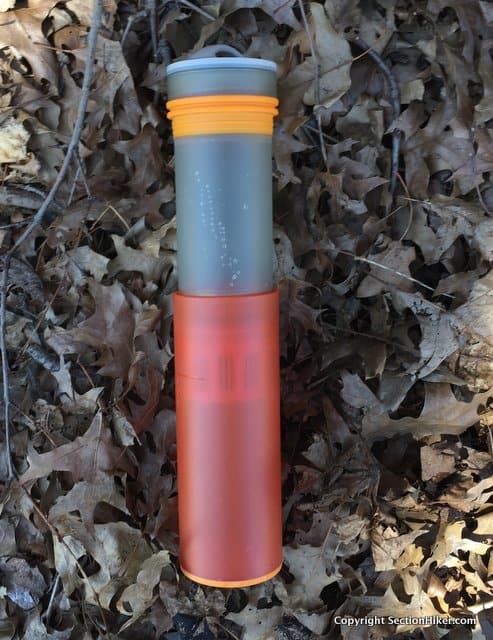
The Grayl is called a “water purifier” because it removes more substances than a “water filter”, including chemicals such as chlorine and iodine, and heavy metals including lead and arsenic. It also removes viruses, making it an excellent solution for international travel, as well.
- Removes 99.9999% of viruses (e.g. Rotavirus, Hepatitis A)
- Removes 99.9999% of bacteria (e.g. E coli, Salmonella)
- Removes 99.999% of protozoan cysts (e.g. Giardia, Cryptosporidium)
- Filters particulates (e.g. sediment, dirt), many chemicals (e.g. chlorine, benzene) and heavy metals (e.g. lead, arsenic)
Unlike other water filters or purifiers, the Grayl can be accidentally frozen and withstand up to three (3) freeze/thaw cycles. Beyond three cycles, purifier performance begins to diminish and the manufacturer recommends that the purifier cartridge be replaced. Still, that’s a handy feature in case you happen to get caught out in the cold unexpectedly.
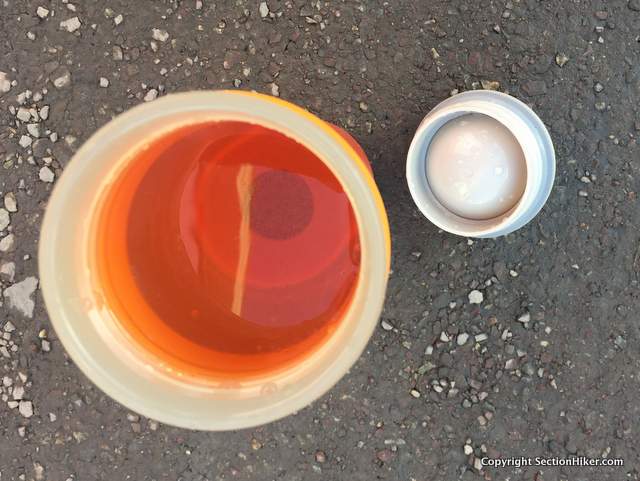
The Grayl purification element is rated for 150 liters/300 uses, making it a better solution for occasional use on day hikes, mountain bike rides, and fishing trips, rather than extended backpacking trips and thru-hikes. The cost of an (Orange) Grayl replacement purifier cartridge is $24.95. Grayl sells a separate blue cartridge called the TAP filter ($14.95) for “frontcountry use”, which only removes taste and odor from water, but not biologicals. Don’t confuse them (the orange “backcountry” purifier cartridge is included when you purchase the bottle purifier.)
Grayl recommends that you replace the filter every 12 months because the activated carbon used to remove chemicals and heavy metals, can degrade over time. This can be limited by drying the filter between use and storing it in an air-tight bag. Since there’s no way to test when the activated carbon has degraded annual replacement is still advisable.
- Weight: 10.9 oz (309 g)
- Capacity: 16 oz (473 ml)
- Flow Rate: 15 seconds per 16 oz (2 liters/minute)
- The lifespan of Replaceable Purifier Cartridge: 300 uses (40 gal/150 L)
- Active Technology: Electroadsorption, ultra-powdered activated carbon, and silver treated zeolites
- Antimicrobial: Yes
- Chemical-free: Yes
- BPA free materials: Yes
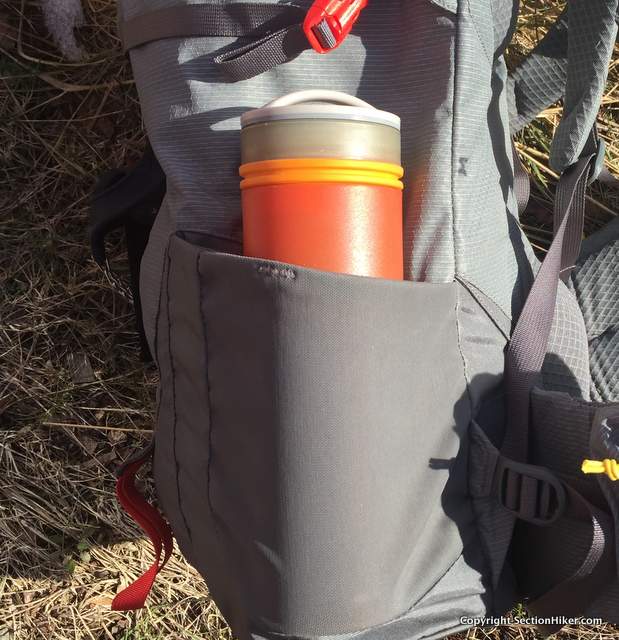
Comparable Bottle-based Water Filters and Purifiers
| Make / Model | Type | Weight | Capacity | Replaceable Filter/Purifier |
|---|---|---|---|---|
| Mizu V12 Vacuum Water Purifier Bottle | Purifier | 15.4 oz | 40 gallons | No |
| RapidPure Intrepid Water Purifier Bottle | Purifier | 9.2 oz | 25 gallons | yes |
| Lifestraw Flex Water Filter Bottle | Filter | 1.7 oz | 500 gallons | No |
| Katadyn BeFree Water Filter Bottle | Filter | 2.3 oz | 250 gallons | Yes |
| Lifestraw Go Water Filter Bottle | Filter | 7.8 oz | 264 gallons | Yes |
Recommendation
Weighing 10.9 ounces (dry), the Grayl Ultralight Purifier Bottle is an innovative backcountry water treatment system that provides excellent protection against biological, chemical, and mineral contaminants, but is just as useful in more civilized or international settings to make your water safer to drink and taste better. I love the fact that it’s completely self-contained and includes an integrated cup and bottle which makes it super easy to pack and carry, without having to deal with extra hoses, reservoirs, bottles, batteries, straws, and wet floppy things on short hikes when there’s plenty of water around and you don’t need to carry much extra.
While you could use the Grayl for backpacking to purify more than 16 ounces of water at a time to carry, the purifier cartridge’s limited lifespan of 150 liters, the cost of replacement cartridges, and the time needed to process larger quantities of water make it a less desirable solution for long-distance backpacking or group trips. Still, I’m impressed by the ingenuity and ease of use of the Grayl Ultralight Purifier Bottle and think it’s an excellent water treatment solution, especially for hikers and outdoors people, who don’t normally have to filter or purify drinking water but want a low barrier alternative that is easy to bring along.
Compare 3 Prices
-

 Amazon US$89.95View
Amazon US$89.95ViewAmazon.com Price: $89.95 (as of 04/26/2024 05:16 GMT-0400) Details
Product prices and availability are accurate as of the date/time indicated and are subject to change. Any price and availability information displayed on Amazon.com at the time of purchase will apply to the purchase of this product.
-
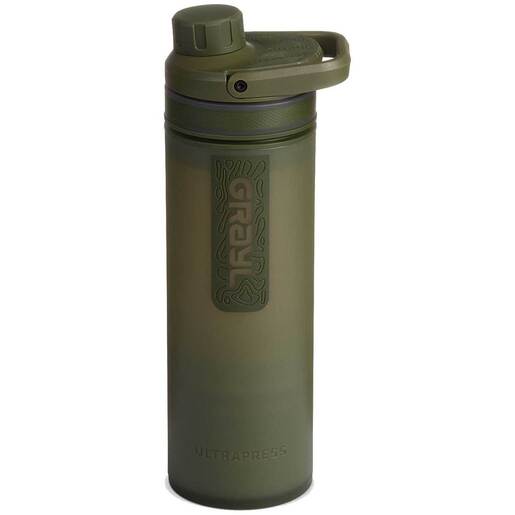
 Sportsman's Warehouse$89.95View
Sportsman's Warehouse$89.95View -
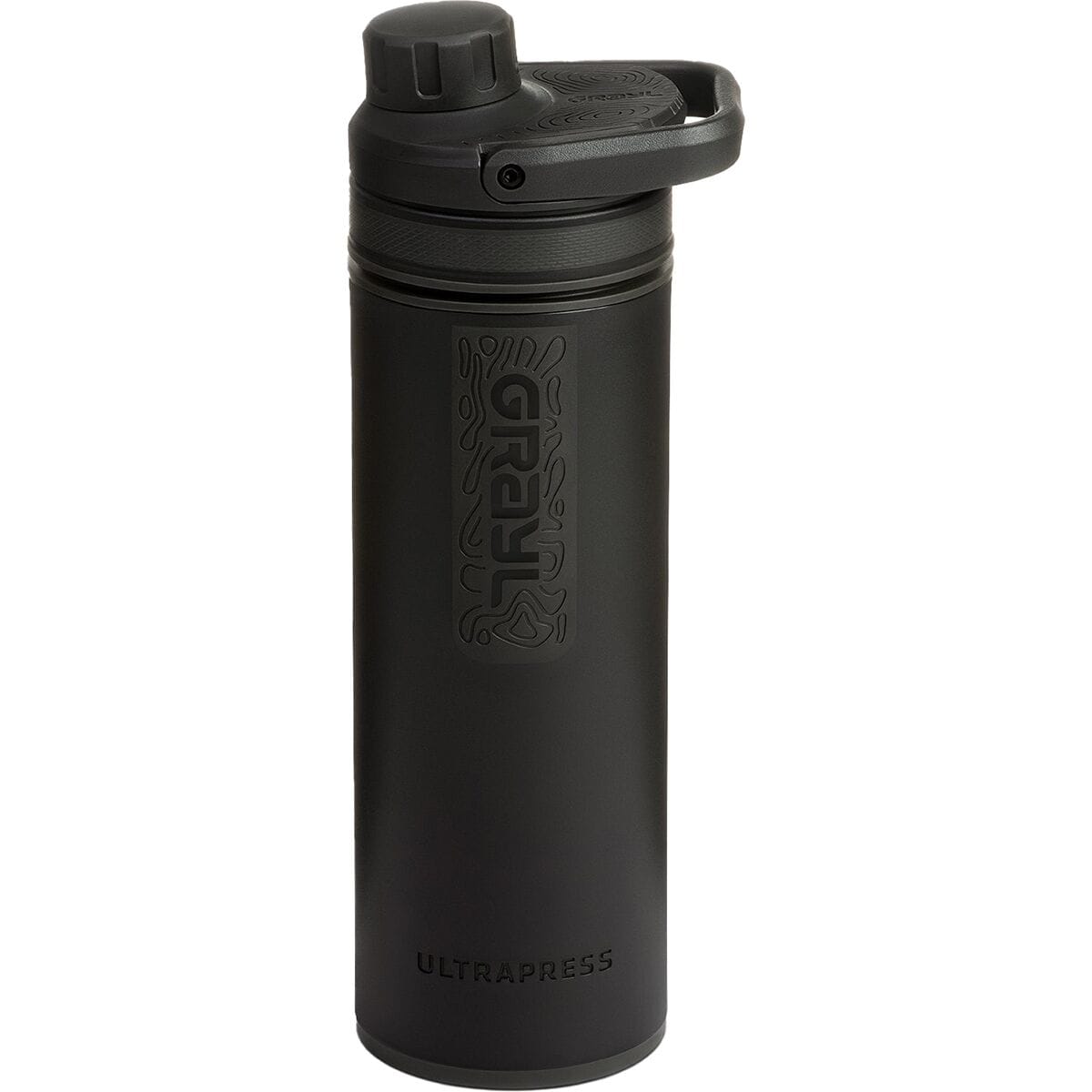
 Backcountry.com$89.95View
Backcountry.com$89.95View
Disclosure: The author received a sample purifier bottle from Grayl but was under no obligation to publish a product review.
SectionHiker is reader-supported. We only make money if you purchase a product through our affiliate links. Help us continue to test and write unsponsored and independent gear reviews, beginner FAQs, and free hiking guides. SectionHiker.com Backpacking Gear Reviews and FAQs
SectionHiker.com Backpacking Gear Reviews and FAQs
This sounds like horse or male bovine manure to me. There is a science called chemistry and anything called “electrosomething or other” ought to make sense within its framework. This does not. This does not pass the smell test as far as the removal of chemicals is concerned. Why should this shiny bauble be able to remove cations or neutrals like benzene based on the description of the operating principle? And will it leave all the other useful cations in the water alone, in other words how does it know the bad actor cations from the good ones?
This appears to be GTX level marketing applied to water purification. Alas when GTX does not work as advertised, you get merely wet.
I don’t know enough about biology to make a valid assessment on its efficiency as a microbiological filter.
The mechanical part of this gadget actually is good idea.
You can’t call yourself a “purifier” without passing more stringent tests from an independent laboratory designed by the EPA. I’m not sure that covers benzene (not sure where that came from) but I think that substantiates their claim that the product removes lead and arsenic. I’ll try to dig up the test result document for you, but the fact that REI sells this product gives me lots of confidence, since I know firsthand that they do their due diligence.
The 21 Century science and technology of using electro-adsorption, activated carbon, silver and nanotechnology to purify water is real.
https://scholar.google.com/scholar?q=electro-adsorption+water+purification&btnG=&hl=en&as_sdt=0%2C5&as_vis=1
We shall see how well this particular product performs as stated in field conditions by thousands of its users. It seems ideal for international travel.
This scientist is impressed.
Better living through chemistry. :-)
I can’t speak for the chemistry and removal of anything here, but in a discussion about this filter on a facebook group, a Canadian microbiologist raised a pretty valid concern about the silver antimicrobial treatment both in effectiveness for the life of the cartridge but also for the big concern of “superbugs” where they mutate and become resistant to our efforts to zap them. We hear about this with antibiotics but apparently there are big potential issues with this approach as well. To me, this filter looks just too weighty and expensive overall for backpacking. Great idea though.
So based on hypothetical mutations, we should’nt buy this product? Folks, I’ve read literally dozens of reviews by independent sources who put the The Grayl through real world tests. And as far as purifying capabilities, The Grayl is superb.
I found myself considering this kind of treatment for an upcoming 5 week trek through China this summer, but decided to go with Rapidpure’s offerings, as they seemed to better fit our needs and they have better longevity. Discounted on Amazon also.
https://www.rapidpure.net/index.asp?pageID=1
Never heard of them. But it sounds likes the same electromagnetic technology used in the Grayl. Might even be their OEM, since the implication is that these folks are the patent holders.
While they do list their EPA biological test results on the web site, I don’t see anything about chemical removal however.
Here’s the amazon link:
https://amzn.to/2o9nwfd
10.9 oz seems a lot for having to carry another reservoir for capacity and storage, but I do like the idea of having clean water ready to go. I currently use a Berky Sport attached to a SmarTube inside a Nalgene soft side.
I’m liking this solution for day hiking, fly-fishing, and mountain biking myself. Much better than a lifestraw, for instance, and even the BeFree since there’s little chance of cross-contamination. Not really an ideal backpacking solution, although there are places like Scotland with abundant water and lots of livestock, where this wouldn’t be a bad fit.
Hey all, this is Travis GRAYL Co-founder. Below are some facts about GRAYL’s Purifier Bottle.
— GRAYL uses relatively new, incredibly powerful purification media that doesn’t rely on ‘size exclusion’ (aka little pores). Instead, it uses electroadsorption and ion exchange to trap impurities.
— The media also contains activated carbon, effective against a range chemicals and heavy metals.
— GRAYL has undergone extensive testing at an independent lab. For a review of the testing we carry out, see here – https://goo.gl/RKw1Nr
— Every new batch of cartridges is tested at the independent lab.
We take the safety of our customers very seriously. Tens of thousands or our bottles have been used all over the world to keep people safe and hydrated. If you have any concerns, please contact me direclty at travismerrigan (at) thegrayl (dot) com
Thank you very much for your interest.
Perfect Travis – Thanks for responding so promptly!
I agree this seems like an ideal product for fishing trips and day hikes where there is plenty of water around.
It would be great to have some type of low tech counter on the bottle that would assist with keeping track of the number of uses. Even a scrolling counter that you advance yourself would work for me. Has something like this been tried? Otherwise I’d just resort to changing the filter element once a year when we switch to daylight savings time.
I’m sure I use my filters beyond their expected service life because I don’t track the number of uses well. Not as big an issue treating our tap water at home but I like to be a bit more careful in the back country.
Does the activated carbon truly remove iodine? If so, given my worry about 3rd world viruses, I could just pretreat my water (from source) with iodine, wait 60 minutes (in the sun?), and then “french press” it.
Why bother with iodine or the grayl. Just use aqua mira drops. Or the grayl and aqua Mira which won’t stain anything. I can’t understand why people bother with iodine. It’s banned in Europe.
I am going to India in a few days. I’ll let you know how it works. I have all my vaccines so it should work.
Hi, how did it work for your travel? I am heading out for a trip and was curious if it worked well for you.
Lovely. Now how do I know when it no longer works? If I’m happily drinking my water over the course of a few years and the whole time the filter stopped working, I’m drinking a lot of lead, arsenic, and other shit and don’t know it until it is too late. No thanks.
Just change it once a year and you’ll be fine.
How can you even tell if your city water is safe?
Travis-
Can GRAYLE filters be used to purify tap water in foreign countries making it safe to drink? I’d like to take these through cambodia, vietnam and thailand.
Yes.
Hey all, great read. I took this puppy for a test spin almost a year ago on a 75 mile trip from Sequoia National Park to the top of Mt Whitney. I absolutely loved it in the beginning but as the trip went on it became harder and harder for me to press down to filter.
Did you filter approx 40gal of water? That is listed as the filter limit. Cannot imagine 40gal for 75mi unless a group etc. Any cloudy water? How long to get the filter pressed? No way to tell much from your post if slowness just a nuisance or rendered the system useless.
Maybe a typo in how you copied the table. Maybe reduces toxic chemicals instead of chemical free. I prefer some nice cold dihydrogen monoxide when I want a drink.
On a more practical side this is a nice twist on water filtering. The water that I use is typically very nice…but is something that may be good in addition/instead of the drops that I normally use. Thanks!
Philip, I just purchased one thru your Backcountry link and got 20% off…cost $47.96
Looking forward to using it in a few weeks.
Great website by the way. Thanks
I used the Grayl Ultralight for the first time a couple of days in the Yellow River State Forest in Iowa. I really like this unit. I also like the fact that it fits in my bottle cage on my bike.
I’ve used it that way too. A very good option for cyclists and bike packers.
HI thank you for the post. this has been very helpful with figuring out which filter/purifier to take on a trip. I was wondering now that Grayl’s prices have come down a lot (filters $25 and a non-stainless steel option) would you consider it a better filter then the straw filters?
Products like a Lifestraw are junk for hiking. No one drinks out if a river using one. Try it sometime…riverbanks are not very friendly to lie down in and drink from. Or streams for that matter. The Grayl is so much better and includes a container to drink from. No comparison really.
Thinking of taking one of these Grayl on a hike down the Florida Trail. The one they gave me is stainless steel and since I cannot tell how old it is I plan on purchasing a travel filter for safety sake. Since they came out with the lighter bottle over the steel one I have, is there any concern about the cartridges not fitting the old style? Thanks CS
Suggest you contact the mfg and ask them. -P.
Hi, I wanted to buy this as a gift for my son. This is by far the best article i have read on the product. Could you pl advise- how can one tell the the filter is working fine or needs to be changed? (I am sure no one keeps a count of number of times or litres of water you are drinking through it!). I understand it is preferable to use at least clear water (not muddy!!!!).
Also, is it necessary to clean and dry the filter between uses, or can it be used as a simple stainless steel or glass bottle- as much as you want? And how do you clean a filter that has “trapped” microbes and sediments, safely????
also, has anyone compared it with water-to-go?
How does the grayl handle the toxins produced by cyanobacteria (blue green algae)?
Suggest you contact the mfg for details or refer to the links lab report.
It does not filter cyanobacteria per: https://thegrayl.com/pages/faqs
“No. GRAYL’s purifier media is not recommended for use with cyanotoxin poisoned drinking water. Cyanotoxins are created when cyanobacteria (or ‘blue algae’) proliferate in freshwater lakes, under certain conditions, likely exacerbated by global warming. Water containing cyanotoxins is very no bueno for human health.
Activated carbon, one technology in GRAYL’s purifier media, can reduce cyanotoxins but not to a level that is sufficient to make the water safe. Reverse osmosis is the only filtration method effective against cyanotoxins.”